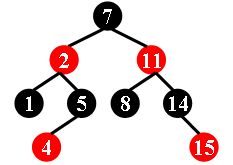1135 Is It A Red-Black Tree (30 point(s))
1135 Is It A Red-Black Tree (30 point(s))
There is a kind of balanced binary search tree named red-black tree in the data structure. It has the following 5 properties:
- (1) Every node is either red or black.
- (2) The root is black.
- (3) Every leaf (NULL) is black.
- (4) If a node is red, then both its children are black.
- (5) For each node, all simple paths from the node to descendant leaves contain the same number of black nodes.
For example, the tree in Figure 1 is a red-black tree, while the ones in Figure 2 and 3 are not.
 |
 |
 |
|---|---|---|
| Figure 1 | Figure 2 | Figure 3 |
For each given binary search tree, you are supposed to tell if it is a legal red-black tree.
Input Specification:
Each input file contains several test cases. The first line gives a positive integer K (≤30) which is the total number of cases. For each case, the first line gives a positive integer N (≤30), the total number of nodes in the binary tree. The second line gives the preorder traversal sequence of the tree. While all the keys in a tree are positive integers, we use negative signs to represent red nodes. All the numbers in a line are separated by a space. The sample input cases correspond to the trees shown in Figure 1, 2 and 3.
Output Specification:
For each test case, print in a line "Yes" if the given tree is a red-black tree, or "No" if not.
Sample Input:
3
9
7 -2 1 5 -4 -11 8 14 -15
9
11 -2 1 -7 5 -4 8 14 -15
8
10 -7 5 -6 8 15 -11 17
Sample Output:
Yes
No
No红黑树的判断。
二叉搜索树的建立、计算从任意一个结点到叶子的黑色结点个数、动态结点二叉树
#include
#include
#include
#include
#include
#include
using namespace std;
int K,N;bool isOK;
struct Node{
int data;Node* left;Node* right;
Node(int d):data(d),left(nullptr),right(nullptr){}
};
void insert(Node* &root,int key){
if(root==nullptr){
root = new Node(key);
return;
}
if(abs(key)data)) insert(root->left,key);
else insert(root->right,key);
}
set s;
void getBlack(Node* root,int cnt){
if(root==nullptr){
s.insert(cnt);
return;
}
if(root->data>0) cnt++;
getBlack(root->left,cnt);
getBlack(root->right,cnt);
}
void dfs(Node* root){
if(root==nullptr) return;
if(root->data<0){
if(root->left!=nullptr&&root->left->data<0) {isOK = false;return;}
if(root->right!=nullptr&&root->right->data<0) {isOK = false;return;}
}
s.clear();
getBlack(root,0);
if(s.size()!=1) {isOK = false;return;}
if(root->left!=nullptr) dfs(root->left);
if(root->right!=nullptr) dfs(root->right);
}
int main(void){
cin>>K;int a;
while(K--){
cin>>N;
Node* root = nullptr;
isOK = true;
for(int i=0;i>a;
insert(root,a);
}
if(root!=nullptr&&root->data<0) isOK=false;
if(isOK){
dfs(root);
}
if(isOK) puts("Yes");
else puts("No");
}
return 0;
} 大神代码:
参考链接:https://blog.csdn.net/richenyunqi/article/details/82292391
#include
using namespace std;
struct Node{//二叉树结点定义
int data,leftNum,rightNum;
Node*left,*right;
Node(int d):data(d),left(nullptr),right(nullptr),leftNum(0),rightNum(0){}
};
void insertTree(Node*&root,int data){//二叉查找树的插入节点算法
if(root==nullptr){
root=new Node(data);
return;
}
if(abs(root->data)>abs(data))
insertTree(root->left,data);
else
insertTree(root->right,data);
}
int getBlackNum(Node*root){//计算左右子树中黑色结点个数
if(root==nullptr)
return 1;
root->leftNum=getBlackNum(root->left);//计算左子树中黑色结点个数
root->rightNum=getBlackNum(root->right);//计算右子树中黑色结点个数
return root->data<0?root->leftNum:root->leftNum+1;
}
bool judge(Node*root){//判断给定的树是否满足4、5条性质
if(root==nullptr)
return true;
bool leftBlack=root->left==nullptr||root->left->data>0;
bool rightBlack=root->right==nullptr||root->right->data>0;
bool f1=root->data>0?true:leftBlack&&rightBlack;//是否满足性质4
bool f2=root->leftNum==root->rightNum;//是否满足性质5
return f1&&f2&&judge(root->left)&&judge(root->right);//递归判断左右子树
}
int main(){
int K,N,a;
scanf("%d",&K);
while(K--){
scanf("%d",&N);
Node*root=nullptr;
for(int i=0;idata>0&&judge(root);
printf("%s\n",isRBT?"Yes":"No");
}
return 0;
}